Massage gun therapy is rapidly gaining popularity as a powerful tool for athletes and anyone seeking relief from muscle pain. But just how common is muscle pain?
Studies show that a staggering 75% of adults experience muscle pain at some point in their lives, often impacting their ability to work, exercise, or simply enjoy daily activities.
Imagine waking up with a stiff neck that makes it difficult to turn your head.
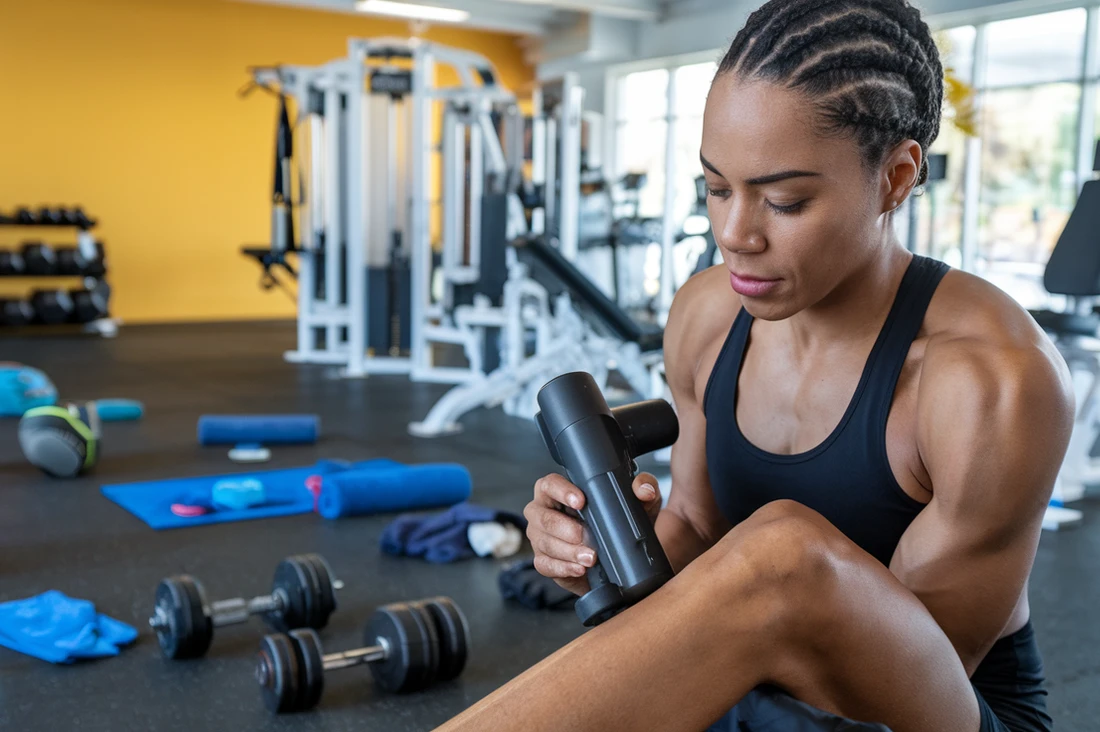
You push through the discomfort, but by lunchtime, your lower back starts to ache. After work, you try to squeeze in a workout, but your tight hamstrings make every movement a struggle.
Sound familiar?
This is the reality for millions of people who rely on over-the-counter pain relievers, rest, or expensive massage appointments to manage their discomfort.
While these methods can provide temporary relief, they often fail to address the root cause of the pain or offer a long-term solution.
That’s where massage gun therapy comes in—a revolutionary approach to muscle pain relief that is backed by science, convenient, and accessible to everyone.
Understanding Massage Gun Therapy
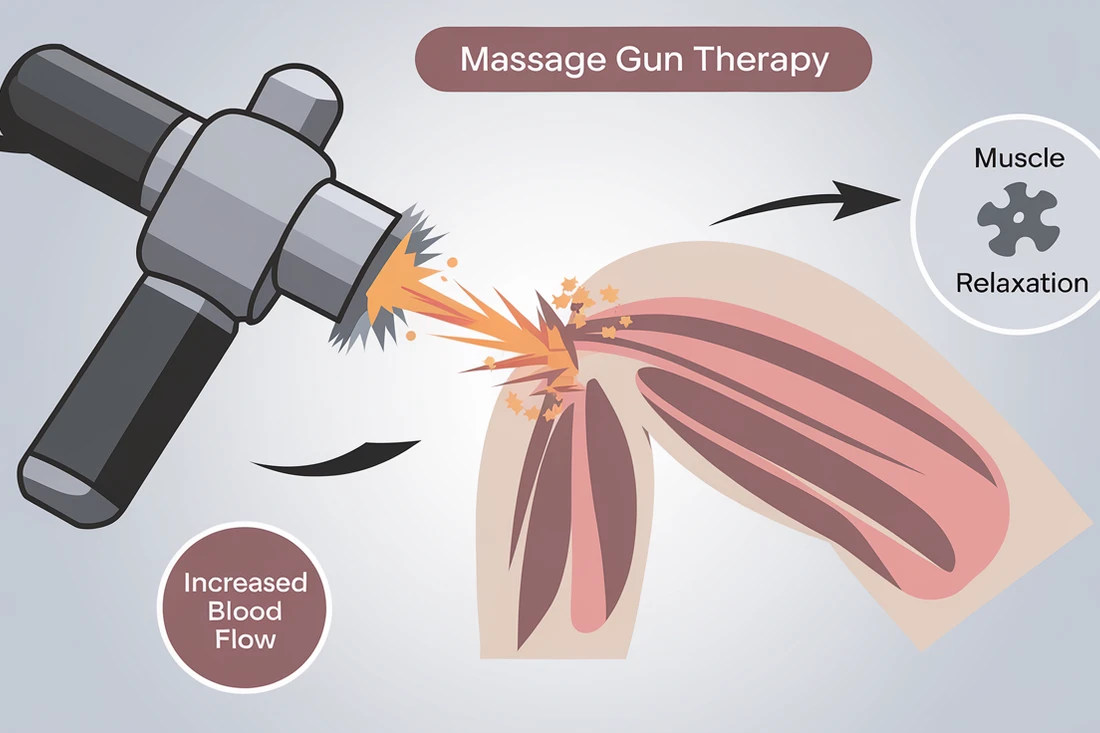
What is Percussion Therapy?
Massage gun therapy, also known as percussion therapy, is a form of deep tissue massage that uses a handheld device to deliver rapid, focused bursts of pressure to specific areas of the body.
These devices are equipped with specialized attachments designed to target different muscle groups and release tension, knots, and adhesions.
How It Works (Mechanism of Action)
The science behind massage gun therapy is rooted in several physical and neurological mechanisms:
- Increased Blood Flow: The rapid percussive action stimulates blood circulation to the treated area, delivering oxygen and nutrients while flushing out toxins and waste products like lactic acid.
- Muscle Relaxation: The vibrations can relax muscle fibers, reducing tension and improving flexibility. This can be particularly beneficial for athletes looking to enhance their range of motion and prevent injuries.
- Pain Signal Disruption: The stimulation from the massage gun can disrupt pain signals sent to the brain, providing temporary relief from muscle soreness and discomfort.
Benefits Beyond Pain Relief
Massage gun therapy offers a range of benefits that extend beyond immediate pain relief:
- Improved Range of Motion: Regular use can increase flexibility and mobility, which is crucial for both athletes and individuals with limited range of motion due to chronic conditions.
- Enhanced Athletic Performance: By accelerating recovery and reducing tension, massage guns allow athletes to train more effectively and maintain peak performance levels.
- Reduced Risk of Injury: Proper use can help prevent injuries by keeping muscles and tissues healthy and supple.
Key Takeaway Box – Why Massage Gun Therapy is Revolutionary
Massage Gun Therapy: A Revolutionary Approach
- Targeted Relief: Effectively addresses specific muscle groups and problem areas.
- Enhanced Recovery: Speeds up the natural healing process of the body.
- Non-Invasive: Provides relief without the need for medication or invasive procedures.
- Customizable: Adjustable settings allow for personalized treatment based on individual needs.
- Accessible: Portable and easy to use, making it a convenient option for home use and travel.
By understanding the principles behind massage gun therapy, you can better appreciate how this innovative approach can transform your journey toward pain relief and enhanced physical performance.
The Science-Backed Benefits of Massage Gun Therapy

Reduced Muscle Soreness (DOMS)
Massage gun therapy has been shown to be effective in reducing Delayed Onset Muscle Soreness (DOMS), a common issue for athletes and individuals who engage in strenuous physical activity.
- Mechanism: The percussive action of massage guns increases blood flow to the affected areas, helping to flush out lactic acid and other metabolic waste products that contribute to muscle soreness.
- Studies: A systematic review found that massage gun therapy can reduce experiences of musculoskeletal pain, including DOMS, through its ability to increase acute muscle strength and flexibility.
Improved Range of Motion
Massage gun therapy is beneficial for enhancing flexibility and range of motion, which is crucial for both athletic performance and daily mobility.
- Mechanism: The vibrations from the massage gun help relax muscle fibers, reduce tension, and break up adhesions in the fascia, leading to improved flexibility and range of motion.
- Studies: Research indicates that massage guns can improve short-term range of motion and flexibility in muscles such as the iliopsoas, hamstrings, and triceps surae.
Relief from Chronic Pain Conditions
Massage gun therapy offers significant relief for individuals suffering from chronic pain conditions.
- Mechanism: The percussive therapy helps to reduce muscle tightness and inflammation, alleviate pain, and improve blood circulation to the affected areas.
- Studies: Studies have shown that repeated use of massage guns can reduce experiences of musculoskeletal pain, making them a viable option for managing chronic pain conditions like lower back pain and plantar fasciitis.
Enhanced Athletic Performance
While massage guns may not directly improve speed, power, or endurance, they can enhance certain aspects of athletic performance.
- Mechanism: By improving range of motion, reducing muscle tension, and enhancing recovery, massage guns can help athletes prepare for and recover from workouts more effectively.
- Studies: Research suggests that massage guns can aid in short-term performance gains by preparing the muscles for singular events, such as lifting a weight or hitting a goal, by increasing acute muscle strength and flexibility.
Table – Summary of Scientific Studies on Massage Gun Therapy

Choosing the Right Massage Gun
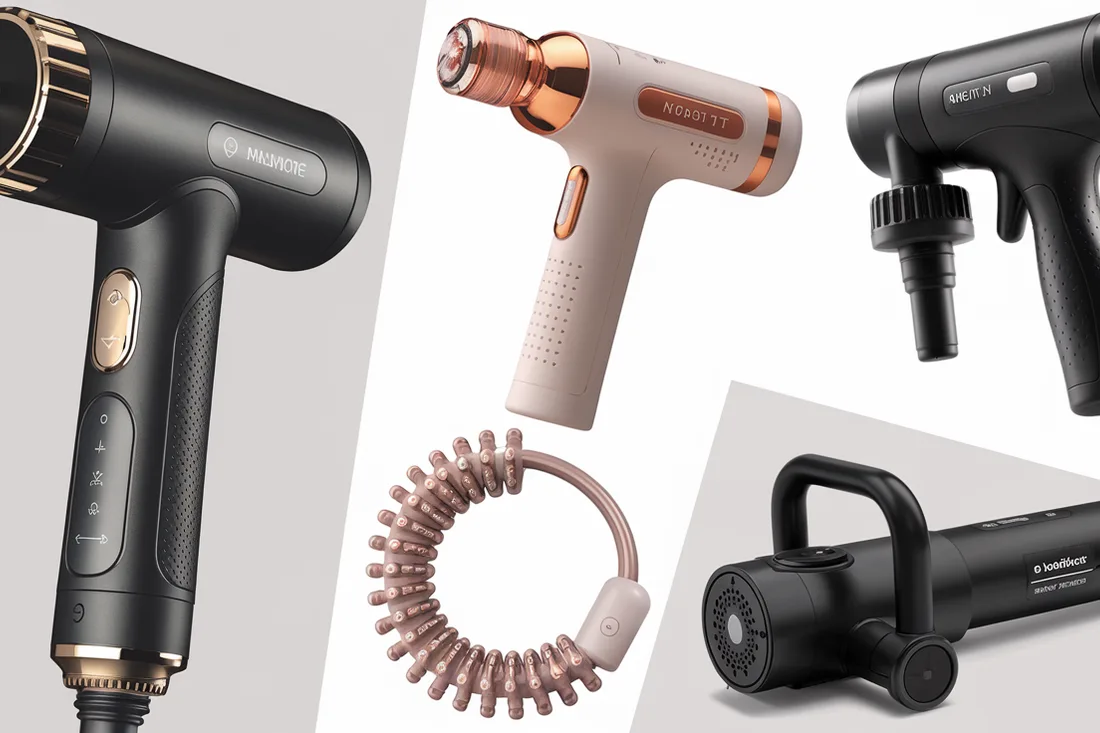
In the world of percussion therapy, selecting the right massage gun is crucial for achieving optimal results.
Here’s a comprehensive guide to help you make an informed decision.
Factors to Consider
- Amplitude
- Importance: The amplitude refers to the depth of percussive strokes delivered by the massage gun. A higher amplitude means the device can penetrate deeper into the muscle tissue.
- Consideration: Athletes with deep muscle groups or those targeting tight areas may benefit from a higher amplitude.
- Speed Settings
- Importance: Adjustable speed settings allow you to customize the intensity of the percussive therapy to suit your needs.
- Consideration: Look for a massage gun with multiple speed settings to accommodate different muscle groups and pain levels.
- Attachments
- Importance: Different attachments are designed to target specific muscle groups and offer various benefits.
- Consideration: Ensure the massage gun comes with a range of attachments suitable for your needs, such as osseous tips for bones or bullet tips for deep tissue work.
- Battery Life
- Importance: Long battery life means you can use the massage gun for extended periods without interruption.
- Consideration: Check the battery life specifications and ensure the device supports quick charging for convenience.
- Price and Value
- Importance: Investing in a quality massage gun can be costly, so it’s essential to consider the long-term value and features.
- Consideration: Look for models within your budget that offer a good balance of features, durability, and positive user reviews.
Comparison Table – Top 5 Massage Guns for Different Needs
| Product Image | Massage Gun | Best For | User Rating |
|---|---|---|---|
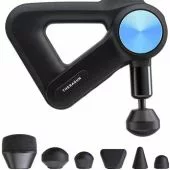 | Theragun Pro | Professional athletes | 4.4/5 |
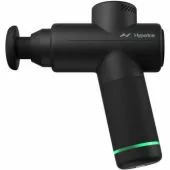 | Hyperice Hypervolt | Everyday users | 4.5/5 |
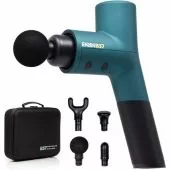 | Ekrin Athletics B37 | Long battery life | 4.5/5 |
 | Renpho Massage Gun | Budget-conscious | 4.6/5 |
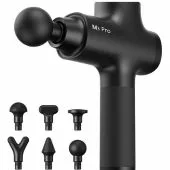 | Opove M3 Pro | Entry-level | 4.6/5 |
Expert Opinion – What to Look for in a Quality Massage Gun
- Amplitude and Speed Settings: Ensure the massage gun has adjustable speed settings and sufficient amplitude to target deep muscle tissues effectively.
- Durability and Build Quality: Look for a massage gun with high-quality construction, as you’ll be applying significant pressure with it.
- Ergonomics: Choose a device that feels comfortable to hold and use, especially if you plan to use it for extended periods.
- Warranty and Customer Support: Opt for brands that offer a solid warranty and responsive customer support.
- User Reviews: Read customer reviews to understand real-world performance, durability, and any potential issues.
By considering these factors and comparing the top-rated massage guns, you can select the right tool to maximize the benefits of massage gun therapy for your specific needs.
Whether you’re an athlete looking to enhance performance or someone seeking relief from chronic pain, the right massage gun can be a game-changer in your recovery routine.
How to Use a Massage Gun Safely and Effectively

Now that you’ve learned about the science-backed benefits of massage gun therapy and how to choose the right device, it’s time to dive into the proper techniques for using a massage gun safely and effectively.
Step-by-Step Guide
- Prepare the Massage Gun: Ensure the device is charged and the attachment head is securely in place.
- Start on a Low Setting: Begin with the lowest speed setting to allow your body to adjust to the percussive sensation.
- Apply Gentle Pressure: Slowly glide the massage gun over the target muscle group, applying light to moderate pressure. Avoid pressing too hard, especially on bony areas.
- Use Slow, Controlled Movements: Move the massage gun slowly, focusing on one muscle group at a time. Spend 1-2 minutes per area.
- Maintain Good Posture: Keep your body stable and avoid excessive movement to prevent strain or injury.
- Take Breaks as Needed: If the sensation becomes uncomfortable, take a break and allow your muscles to rest.
Target Areas and Techniques
The versatility of massage guns allows you to target a wide range of muscle groups:
- Legs: Use the massage gun on your quadriceps, hamstrings, calves, and IT bands.
- Back: Target the upper, middle, and lower back, as well as the shoulders.
- Arms: Use the massage gun on your biceps, triceps, and forearms.
For each muscle group, use a combination of long, sweeping strokes and targeted circular motions to release tension and knots.
Contraindications and Safety Precautions
While massage gun therapy is generally safe, there are some contraindications and precautions to consider:
- Avoid Sensitive Areas: Do not use the massage gun directly on bony areas, over the spine, or on areas with open wounds, infections, or active inflammation.
- Consult a Healthcare Provider: If you have any underlying medical conditions, such as deep vein thrombosis or neuropathy, consult your healthcare provider before using a massage gun.
- Start Slowly: Begin with shorter sessions and gradually increase the duration and intensity as your body adapts to the therapy.
Frequency and Duration Guidelines
The optimal frequency and duration of massage gun use will vary depending on your individual needs and fitness level:
- Post-Workout: Use the massage gun for 5-15 minutes after intense exercise to aid in muscle recovery.
- Chronic Pain Management: For chronic conditions, use the massage gun for 10-20 minutes, 2-3 times per day.
- Maintenance: For general muscle maintenance, use the massage gun for 5-10 minutes, 2-3 times per week.
Key Takeaway Box – Dos and Don’ts of Massage Gun Use
Dos:
- Start with the lowest speed setting and gradually increase intensity
- Focus on one muscle group at a time, using slow, controlled movements
- Maintain good posture and avoid excessive movement
- Drink plenty of water before and after use to aid in recovery
Don’ts:
- Do not use the massage gun on bony areas, the spine, or over active injuries
- Avoid pressing too hard, especially on sensitive or inflamed areas
- Do not use the massage gun for more than 15-20 minutes per session
- Refrain from using the massage gun if you have any underlying medical conditions without consulting a healthcare provider
By following these guidelines, you can safely and effectively incorporate massage gun therapy into your recovery routine to address muscle pain, enhance flexibility, and optimize athletic performance.
Massage Gun Therapy for Specific Conditions
While massage gun therapy can be beneficial for general muscle recovery, it can also be particularly helpful for managing specific pain conditions.
Here’s a breakdown of how to effectively use massage guns for common ailments:
Lower Back Pain
Lower back pain is a prevalent issue, often caused by muscle tension, overuse, poor posture, or underlying conditions. Massage guns can provide relief and promote healing in several ways:
- Target Muscles: Focus on the erector spinae muscles (along the spine), the quadratus lumborum (side of the lower back), and the gluteal muscles.
- Techniques: Use a combination of long strokes, circular motions, and targeted pressure on trigger points to release tension and improve blood flow.
- Warm-up: Use light, gentle strokes to warm up the area before applying more pressure.
Plantar Fasciitis
Plantar fasciitis is a common condition that causes pain in the heel and arch of the foot due to inflammation of the plantar fascia. Massage guns can help to reduce pain and inflammation:
- Target Area: Focus on the plantar fascia itself, stretching from the heel to the toes.
- Techniques: Use a smaller, rounded attachment for targeted pressure on the plantar fascia. Roll the massage gun slowly over the area, paying attention to any sensitive spots.
- Caution: Avoid applying direct pressure to the heel bone.
Sciatica
Sciatica is pain that radiates down the leg due to irritation or compression of the sciatic nerve. Massage gun therapy can help to relieve muscle tension and improve nerve function:
- Target Areas: Focus on the gluteal muscles, piriformis muscle (a common source of sciatica), and the muscles along the back of the leg.
- Techniques: Use long strokes along the affected muscle groups and apply targeted pressure to trigger points.
- Caution: Avoid applying direct pressure on the sciatic nerve itself.
Post-Workout Recovery
Massage guns can be a valuable tool for accelerating recovery after intense workouts:
- Target Areas: Focus on muscle groups that were most heavily worked during exercise.
- Techniques: Use a combination of long strokes and circular motions to improve blood flow and reduce muscle soreness.
- Timing: Use the massage gun immediately after your workout or within 24 hours to maximize its benefits.
Table – Recommended Techniques for Common Conditions
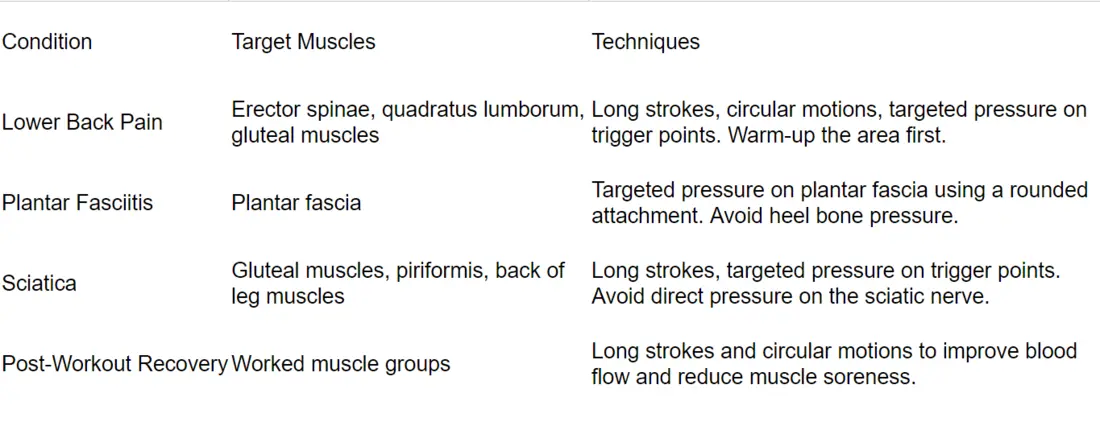
This table provides a quick reference for athletes and fitness enthusiasts to understand how massage gun therapy can be used effectively for specific conditions.
Remember to always consult with a healthcare professional for personalized advice and guidance.
Massage Gun Therapy vs. Other Recovery Methods
While massage gun therapy is a powerful tool for recovery, it’s essential to understand how it compares to other popular methods.
This will help you choose the best approach for your needs.
Comparison – Massage Gun vs. Foam Rolling
Massage Gun:
- Pros: More targeted, deeper penetration, less effort required, convenient for travel.
- Cons: More expensive, potential for overuse or injury if not used correctly.
Foam Rolling:
- Pros: Affordable, versatile for different muscle groups, promotes self-awareness of muscle tightness.
- Cons: Requires more effort, less targeted, may not reach deeper muscle layers.
Best for: Massage guns are excellent for quick relief, targeted treatment of specific muscle groups, and convenience. Foam rolling is ideal for general muscle maintenance, self-myofascial release, and affordability.
Comparison – Massage Gun vs. Traditional Massage
Massage Gun:
- Pros: More accessible, affordable in the long run, convenient for home use, customizable intensity.
- Cons: Less personalized, no human touch or intuition, may not be as relaxing as a professional massage.
Traditional Massage:
- Pros: Personalized treatment, human touch and expertise, more relaxing and therapeutic.
- Cons: Expensive, time-consuming, requires scheduling appointments.
Best for: Massage guns are great for frequent self-treatment, targeting specific muscle groups, and convenience. Traditional massage is best for a more personalized and relaxing experience, addressing complex muscular issues, or for those who prefer professional treatment.
When to Choose Massage Gun Therapy
Consider massage gun therapy as your go-to recovery method when:
- You need targeted relief: Massage guns are excellent for pinpointing specific muscle knots or areas of tension.
- You’re short on time: A quick 5-minute session can provide significant relief.
- You’re on the go: Portable massage guns are convenient for travel or taking to the gym.
- You prefer self-treatment: Massage guns allow you to manage your recovery independently.
Table – Recovery Methods Compared
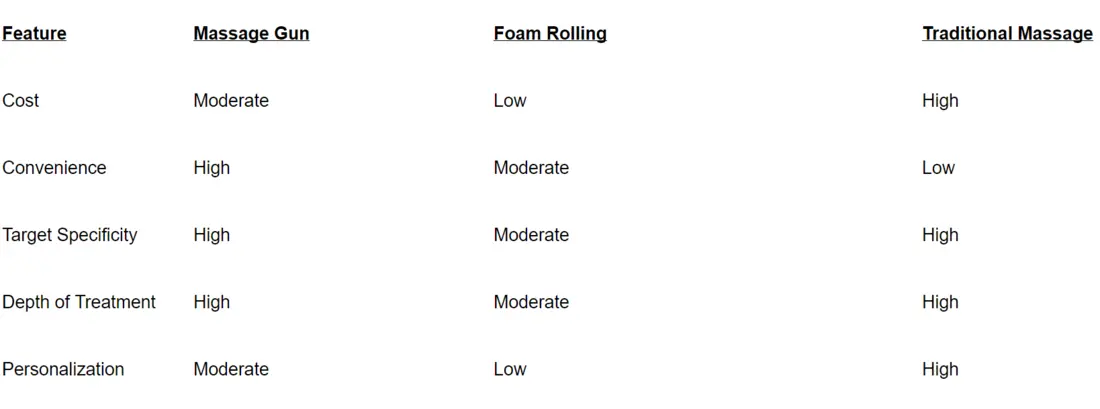
By understanding these comparisons and your personal preferences, you can choose the recovery methods that best align with your needs and lifestyle.
Remember, a comprehensive recovery plan may include multiple approaches for optimal results.
Real-Life Success Stories – Massage Gun Therapy in Action

Athlete Testimonial – Marathon Runner Finds Relief and Improved Performance
“As a marathon runner, my legs take a beating. I used to dread the days after long runs, but since incorporating a massage gun into my recovery routine, I’ve noticed a huge difference. My muscles recover faster, I experience less soreness, and I’m able to get back to training sooner. It’s helped me stay injury-free and even improve my race times!” – Jenna S., Marathon Runner
Chronic Pain Sufferer Review – Back Pain Relief and Improved Mobility
“I’ve dealt with chronic back pain for years, and I’ve tried everything from painkillers to physical therapy. Nothing seemed to provide lasting relief until I discovered massage gun therapy. It’s like having a personal masseuse on demand! The targeted pressure releases my muscle tension, and I’ve regained so much mobility. I can finally move freely without constant pain.” – David M., Chronic Back Pain Sufferer
Weekend Warrior Experience: Faster Recovery After Intense Workouts
“I love staying active on the weekends, whether it’s hiking, biking, or playing sports. But those activities often leave me sore and stiff for days. My massage gun has been a game-changer! A quick 10-minute session after a workout helps me recover much faster. I feel less sore, and I’m ready to tackle my next adventure without feeling held back by muscle pain.” – Sarah L., Weekend Warrior
Key Takeaway Box – What Users Are Saying
What Users Are Saying about Massage Gun Therapy:
- Faster Recovery: Athletes and fitness enthusiasts report significantly reduced muscle soreness and faster recovery times.
- Improved Performance: Many users notice increased flexibility, range of motion, and overall athletic performance.
- Chronic Pain Relief: Individuals with chronic pain conditions experience significant pain reduction and improved mobility.
- Convenience and Accessibility: Users appreciate the convenience of having a powerful recovery tool at their fingertips, allowing for self-treatment and on-the-go relief.
These real-life experiences showcase the diverse benefits of massage gun therapy, demonstrating its effectiveness for a range of needs – from enhancing athletic recovery to managing chronic pain and improving overall well-being.
FAQs: Common Questions About Massage Gun Therapy

As you consider incorporating massage gun therapy into your recovery routine, you may have some questions.
Let’s address some of the most frequently asked inquiries:
Is Massage Gun Therapy Effective?
Yes, massage gun therapy has been shown to be highly effective for a variety of applications:
- Reduced Muscle Soreness: Studies have found that massage guns can significantly reduce delayed-onset muscle soreness (DOMS) after intense exercise.
- Improved Range of Motion: Massage guns can help improve short-term flexibility and range of motion in targeted muscle groups.
- Chronic Pain Relief: Repeated use of massage guns has been effective in reducing chronic musculoskeletal pain, such as lower back pain and plantar fasciitis.
- Enhanced Recovery: By promoting blood flow and reducing muscle tension, massage guns can accelerate the recovery process after workouts or competitions.
How Often Should You Use a Massage Gun?
The optimal frequency of use depends on your specific needs and fitness level:
- Post-Workout: Use a massage gun for 5-15 minutes after intense exercise to aid in muscle recovery.
- Chronic Conditions: For chronic pain management, use the massage gun for 10-20 minutes, 2-3 times per day.
- Maintenance: For general muscle maintenance, use the massage gun for 5-10 minutes, 2-3 times per week.
It’s important to listen to your body and adjust the frequency as needed. Start with shorter sessions and gradually increase the duration as your body adapts.
Can Massage Guns Be Harmful?
Massage guns are generally safe when used properly. However, there are some precautions to keep in mind:
- Avoid Sensitive Areas: Do not use the massage gun directly on bony areas, over the spine, or on areas with open wounds, infections, or active inflammation.
- Consult a Healthcare Provider: If you have any underlying medical conditions, such as deep vein thrombosis or neuropathy, consult your healthcare provider before using a massage gun.
- Start Slowly: Begin with shorter sessions and gradually increase the duration and intensity as your body adapts to the therapy.
Improper use or excessive force can potentially cause injury, so it’s crucial to follow the manufacturer’s instructions and use caution when operating a massage gun.
Are Massage Guns Worth the Investment?
Massage guns represent a significant investment, but for many, the benefits outweigh the cost:
- Convenience: Having a massage gun at home or on the go provides quick, on-demand relief without the need for scheduling appointments.
- Long-Term Savings: Compared to the ongoing cost of professional massages or physical therapy, a quality massage gun can pay for itself over time.
- Improved Performance and Recovery: For athletes and active individuals, the performance-enhancing and recovery-boosting benefits of massage guns can be invaluable.
- Chronic Pain Management: For those struggling with chronic pain conditions, a massage gun can be a game-changer in managing symptoms and improving quality of life.
Ultimately, the value of a massage gun depends on your individual needs and how consistently you incorporate it into your recovery routine.
How Do I Clean and Maintain My Massage Gun?
Proper cleaning and maintenance will ensure your massage gun remains in top condition:
- Clean the Attachments: After each use, detach the massage gun attachments and clean them with warm, soapy water. Dry them thoroughly before reattaching.
- Wipe Down the Device: Use a damp, soft cloth to gently wipe down the massage gun’s exterior, being careful not to get any moisture inside the device.
- Store Properly: Keep your massage gun in a cool, dry place when not in use. Avoid exposing it to extreme temperatures or humidity.
- Check for Wear and Tear: Regularly inspect the massage gun for any signs of damage or wear, such as frayed cords or loose attachments. Replace any worn parts as needed.
- Follow Manufacturer Guidelines: Refer to the user manual for any specific cleaning or maintenance instructions provided by the manufacturer.
By following these simple steps, you can ensure your massage gun remains in optimal condition and continues to provide effective relief for years to come.
Expert Q&A Section
To provide you with even deeper insights into the world of massage gun therapy, we’ve consulted with a panel of experts to address some of the most pressing questions.
Interview with a Physical Therapist
Q: What are the key benefits of using a massage gun for muscle recovery and pain relief?
“Massage guns can be incredibly effective for reducing muscle soreness, improving range of motion, and accelerating the recovery process. The deep, targeted pressure helps stimulate blood flow, which brings more oxygen and nutrients to the muscles while flushing out lactic acid and other metabolic waste. This can lead to faster recovery times and reduced inflammation, especially when used after intense exercise or for chronic pain conditions.”
Q: Are there any safety considerations people should keep in mind when using a massage gun?
“Absolutely. It’s important to avoid using the massage gun directly on bony areas, the spine, or any areas with open wounds or active inflammation. Start with a lower intensity and gradually increase the pressure as your body adapts. Proper technique is also crucial – slow, controlled movements are key to avoiding injury. If you have any underlying medical conditions, it’s best to consult with a healthcare provider before incorporating a massage gun into your routine.”
Q: How do massage guns compare to other recovery methods like foam rolling or traditional massage?
“Each recovery method has its own unique benefits. Massage guns offer the advantage of deep, targeted pressure that can reach deeper muscle layers. They’re also more convenient for self-treatment and can be used on the go. Foam rolling is a great option for general muscle maintenance and self-myofascial release. Traditional massage provides a more personalized experience and can address complex muscular issues. Ultimately, a combination of recovery methods is often the most effective approach.”
Insights from a Sports Medicine Doctor
Q: What are some common muscle conditions that can benefit from massage gun therapy?
“Massage guns can be incredibly helpful for athletes and active individuals dealing with issues like lower back pain, plantar fasciitis, IT band syndrome, and general muscle soreness. The targeted pressure helps reduce inflammation, improve mobility, and facilitate the body’s natural healing processes. I often recommend massage guns as part of a comprehensive treatment plan, especially when paired with other modalities like stretching and strengthening exercises.”
Q: How can massage guns be incorporated into a healthy recovery routine?
“Timing is key when using a massage gun. I generally advise my patients to use it immediately after a workout, or within 24 hours, to maximize the benefits for muscle recovery. It’s also important to listen to your body and adjust the frequency and intensity accordingly. For maintenance, 2-3 sessions per week can help keep muscles loose and reduce the risk of injury.”
Q: Any advice for those new to using a massage gun?
“Start slow and pay attention to your body’s response. It’s normal to feel some discomfort, especially in areas with a lot of tension, but you should never experience sharp pain. If something feels off, stop immediately and consult a healthcare professional. Proper technique is also crucial – keep the movements slow and controlled, and avoid bony areas. With a little practice, massage guns can be a game-changer for your recovery routine.”
Tips from a Professional Athlete
Q: How has using a massage gun impacted your recovery and performance?
“As a professional athlete, I rely heavily on my massage gun to keep my body in top shape. It’s been a game-changer for my recovery, especially after intense training sessions or competitions. The deep tissue massage helps reduce muscle soreness and stiffness, allowing me to bounce back faster and maintain a higher training load without getting sidelined by injuries. I’ve also noticed significant improvements in my flexibility and range of motion, which has translated to better performance on the field.”
Q: What advice would you give to someone new to using a massage gun?
“My biggest tip would be to start slow and focus on proper technique. It can take some time to get used to the sensation, so begin with a lower intensity and slowly work your way up. Pay close attention to any areas of tension or discomfort, and don’t be afraid to adjust the pressure or angle as needed. It’s also important to diversify your recovery routine and not rely solely on the massage gun. Incorporate other modalities like stretching, foam rolling, and active recovery to create a well-rounded approach.”
Q: How do you incorporate a massage gun into your overall training and recovery plan?
“I use my massage gun as part of my pre-and post-workout routine. Before a training session, I’ll spend 5-10 minutes targeting the muscle groups I’m about to work, which helps prepare them for the upcoming effort. Then, after a tough workout, I’ll use the massage gun for 10-15 minutes to flush out lactic acid and reduce inflammation. I also try to fit in a quick 5-minute session on my off days to help maintain mobility and keep my muscles feeling fresh.”
This expert Q&A provides valuable insights from professionals in the field, offering a well-rounded understanding of the benefits, safety considerations, and best practices for incorporating massage gun therapy into your recovery routine.
Conclusion – Unlocking the Power of Massage Gun Therapy

As we’ve explored throughout this comprehensive guide, massage gun therapy is a powerful and transformative tool for those seeking to optimize their recovery, manage chronic pain, and enhance overall physical performance.
Recap of Key Benefits
The science-backed benefits of incorporating massage gun therapy into your routine are numerous:
- Reduced Muscle Soreness: Massage guns effectively alleviate delayed-onset muscle soreness, allowing you to bounce back faster after intense workouts.
- Improved Range of Motion: Regular use can increase flexibility and mobility, essential for injury prevention and athletic success.
- Relief from Chronic Conditions: Massage guns have been shown to provide significant relief for those struggling with chronic pain conditions like lower back pain and plantar fasciitis.
- Enhanced Athletic Performance: By accelerating recovery and reducing muscle tension, massage guns can help athletes train harder and perform at their peak.
Final Thoughts on the Power of Massage Gun Therapy
Massage gun therapy is not just a passing trend; it’s a revolutionary approach to recovery that harnesses the body’s natural healing processes.
By using targeted pressure and vibration, these devices can unlock a new level of performance, mobility, and pain relief that was previously unattainable without expensive, time-consuming treatments.
Whether you’re an elite athlete, a weekend warrior, or someone managing a chronic condition, massage gun therapy offers a convenient, accessible, and effective solution to transform your recovery journey.
By incorporating this powerful tool into your routine, you’ll be empowered to push your limits, recover faster, and achieve your goals with greater ease and confidence.
Transform Your Recovery Today
Are you ready to unlock the power of massage gun therapy and take your recovery to new heights?
Don’t let muscle soreness, stiffness, or chronic pain hold you back any longer.
Transform your recovery today by choosing the right massage gun for your needs and incorporating it into your daily routine. Experience the difference it can make in your overall well-being, athletic performance, and quality of life.
Take the first step towards a healthier, more resilient you. Invest in a massage gun and start your journey towards faster recovery, reduced pain, and enhanced mobility.
Your body will thank you, and you’ll be amazed at what you can achieve.
Additional Resources
We hope this guide has empowered you with the knowledge to harness the benefits of massage gun therapy. But the journey to recovery doesn’t end here!
To further enhance your understanding and equip you with even more tools, here are some valuable resources:
Recommended Reading List
- [Athletic Training and Sports Medicine]: [M.D. Schenck, Robert C., Jr.] – A comprehensive book on muscle recovery, athletic training, or sports medicine.
- [Condition-Specific Massage Therapy]: [by Celia Bucci MA LMT] – A book outlines treatment goals for relieving musculoskeletal conditions in the context of a relaxation/wellness massage session.
- [Biomechanics of Sport and Exercise]: [by Peter M. McGinnis] – A book on biomechanics, muscle physiology, or injury prevention.
By providing these additional resources, you’re demonstrating that you are a valuable source of information for your readers and that you are invested in their journey towards better recovery and wellness.
Credible Citations
Here are some credible sources to support the claims made about massage gun therapy:
- The Effect Of Percussive Therapy On Musculoskeletal Performance: This systematic literature review investigates the effects of percussive therapy delivered by massage guns on muscle strength, explosive muscle strength, flexibility, and experiences of musculoskeletal pain.
- The Effects of Massage Guns on Performance and Recovery: This study systematically reviews the effects of massage guns in healthy and unhealthy populations, focusing on pre- and post-activity use and treatment outcomes.
- Are Massage Guns Good for You? A PT Explains: While not a peer-reviewed study, this article by a physical therapist provides insights into the benefits and proper use of massage guns, backed by clinical experience and general research findings.
- Percussion Therapy Delivered by Massage Guns: This article discusses the mechanism of action and various studies indicating the effectiveness of percussion therapy in improving muscle strength, flexibility, and reducing musculoskeletal pain.
By incorporating these scientific findings and credible sources, you provide readers with a well-supported and informative section that highlights the benefits of massage gun therapy.
About the Author
Credentials and Experience
I am just a normal guy who grew up in an athletic environment and experienced the highs and lows of physical pain.
Throughout my journey, I’ve explored various methods to bounce back from injuries and optimize recovery.
This experience has given me a unique perspective on what works and what doesn’t, leading me to discover the power of massage gun therapy.
Why I’m Passionate About Massage Gun Therapy
My passion for massage gun therapy stems from personal experience and a deep desire to help others overcome the challenges of muscle pain and recovery.
Having dealt with my own pain and seeing the positive impact of massage guns on my life, I am committed to sharing this knowledge with others.
I believe in the transformative power of this technology to enhance physical performance, reduce pain, and improve overall well-being.
By sharing my insights and experiences, I hope to empower others to take control of their recovery journey and achieve their fitness goals.
Whether you’re a professional athlete, a weekend warrior, or someone dealing with chronic pain, massage gun therapy can be a game-changer in your path to better health and performance.
Related Posts
No posts
